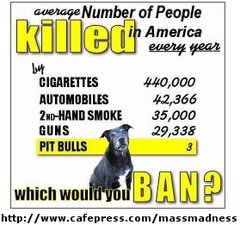Afternoon Court Session of May 15th - Steve Barker's summary (part 2)
Court Report May 15 11:00pm
Here is my summary of the afternoon of May 15.
My apologies for the late report. I just got home now. My attempts at "cellphone blogging" have been remarkably unsuccessful.
Trial Fairness
Clayton Ruby continued his arguments, focusing a lot on his third argument - trial fairness.
He first focused on Section 19 of the DOLA, related to accepting into evidence a document purported to be from a veterinarian, stating that a dog is a "pit bull".
This is a case of the legislation forcing a judge to admit into evidence what would normally NOT be admissible - a document of opinion without a witness testifying. The crown can choose not to use such a document, but if they do, the legislation does not give the judge the choice to rule on the admissibility of the evidence. It must be accepted. This is not normal or acceptable.
In addition, defence cannot cross-examine the veterinarian because he does not need to testify. They can subpoenae him as their own witness, but at their own cost. Even then, they cannot cross-examine him, only examine him "in chief". Basically, it's more difficult to "go hard" at him.
The credibility of the veterinarian is crucial, considering that the identification of breed is the crux of the legislation. This document does not even have to be sworn in front of a JP. There are no safeguards in this substitution to ensure that the statement is likely true.
There is also a mandatory presumption of fact. It substitutes non-evidence (document) for evidence (witness testimony) without an overriding reason why the original witness should not be examined. There are valid reasons for not having a witness testify (protection, national interest, etc), but protecting a vet from cross-examination is not one of them.
Clayton Ruby also asked that the judge deem inadmissible some government evidence based on legislative and committee Hansards (transcripts of legislature and committee sessions). The legislative Hansard contained some of Michael Bryant's comments and the committee Hansard contained statements made by members of the public. Case precedent shows a reluctance by courts to accept politicians' legislative comments as evidence and case precedent always refuses to accept statements by members of the public in committee Hansards. This is because neither of these are sworn statements and neither have the option of cross-examination.
The government also has a responsibility to show that there were reasonable alternatives, if they were proposed. Their Hansard choices were biased in their favour, while they ignored the 80% of the committee presentations against the ban, many of which presented reasonable and less restrictive alternatives.
Reasonableness Test
A law that imprisons citizens can fail the vagueness and overbroad tests (section 7 of the charter) can still be saved by section 1 if the government can prove that the legislation, even though overbroad or vague, has a rational connection to its purpose. The purpose of this legislation is to reduce dog bites. Is the legislation reasonable enough to be saved by section 1 in order to accomplish this purpose?
Ruby then listed all the reasons why banning pit bulls will not solve the problem of dog bites, including quoting studies and witness testimony.
This legislation, as a result of the reasons listed earlier, fails the rational connection test. This is actually quite rare in section 1 challenges. Most section 1 challenges focus on legislation not being the least restrictive option. This legislation also fails that test, since the government was provided with ample testimony offering proven alternatives.
Using the recent Supreme Court ruling on the Sikh student who wanted to take a kirpan (traditional religious dagger) to school. In finding in favour of the student, the Supreme Court said that the risk to community safety must be unequivocably proven in order to not violate the charter. Since even the government's own witnesses agreed that most dogs targeted in this legislation are happy, friendly pets that will never bite anyone, the risk to community safety is not great enough to justify vague or overbroad legislation.
The Supreme Court did rule that a breathalyser test law could be saved by section 1 because the "extreme" measures were rationally connected to the purpose of the legislation. This was proven using scientific research and statistics. Our legislation has not been proven this way. In addition, in order not to be unreasonably restrictive on citizens, the test must be performed twice with at least fifteen minutes in between tests, and must be completed within two hours. This shows that the lawmakers made every attempt to keep the infringement reasonable.
Federal Animal Pedigree Act
Breese Davies, Ruby's associate who has done a lot of work on this case, presented an argument that the provincial law conflicts with the federal Animal Pedigree Act. The federal APA stipulates that the only people allowed to identify breeds are pedigree registries, in this case the Canadian Kennel Club. Nobody else in this country is allowed to identify a breed and the only reason that the pedigree registry is allowed to identify the breed is if they have the pedigree of the dog. In conflict with this federal law, the provincial legislation, without any consideration that there is a federal law prohibiting it, gives the province the power to identify breeds and then hands that power even further to veterinarians, whose regulating body (the OVMA) has testified that it is impossible for them to perform this function.






























2 comments:
Great to see that we're keeping on top of things. ;)
Steve's keeping on top of things. I'm a basket case!!!!!
Post a Comment